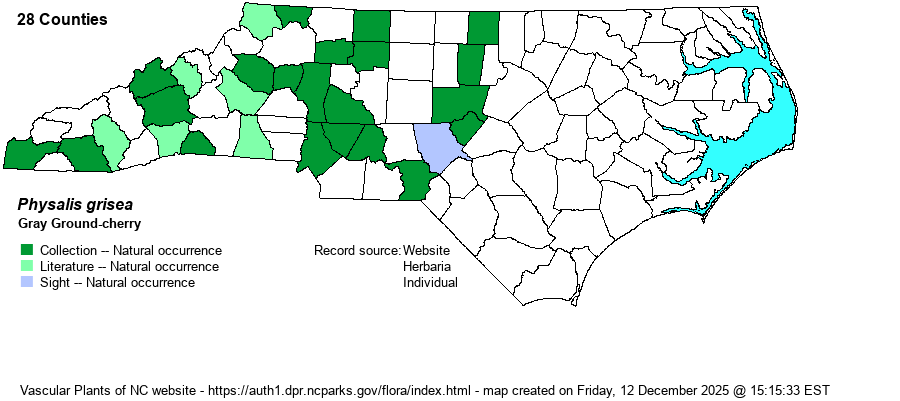| Author | (Waterfall) M. Martinez | |
| Distribution | Scattered over most of the Mountains and Piedmont, at least to Person, Chatham, and Lee counties, and thus perhaps absent in the far northeastern Piedmont.
This is a species of the Eastern states, poorly known or collected, from eastern Canada and ME south to FL and TX, but with only scattered records for many states.
| |
| Abundance | Somewhat rare to uncommon over the Mountains and western 2/3-rds of the Piedmont, and apparently rare in the eastern Piedmont if not absent in some counties. Generally poorly known or collected and likely overlooked as several other species, especially as its taxonomy has been muddled and many taxa are quite similar. | |
| Habitat | This is a species of mesic soils, of open wooded slopes and edges, but it also can occur in disturbed places. | |
| Phenology | Blooms from July to September, and fruits from August to October. | |
| Identification | This is a distinctive hoary/hispid species of Physalis, owing to very dense hairs over most of the stem and leaves. The plants grow to about 1.5 feet tall, with some branching. The leaves are widely ovate, very different in size over the plant, the largest about 3 inches long and 2 inches wide, with low to moderate teeth on the margins. The yellow flowers dangle like others in the genus, about 1-inch across. The fruiting "pod" is strongly 5-angled and about 1-inch long. A few other species are somewhat similar; check Weakley (2018) for separation features. | |
| Taxonomic Comments | RAB (1968) named this as a variety -- P. pubescens var. grisea. Older references gave it species status, typically named as P. pruinosa. Most references now name it as P. grisea.
| |
| Other Common Name(s) | Hairy Ground-cherry, Strawberry-tomato | |
| State Rank | S3 | |
| Global Rank | G5? | |
| State Status | | |
| US Status | | |
| USACE-agcp | | |
| USACE-emp | | |

